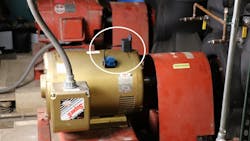Adjusting to the new normal: The need for pervasive remote monitoring
It is hard to believe, but just a few short months ago businesses in the United States were operating in their usual ways. As the effects of the COVID-19 pandemic quickly swept across the nation, many businesses were forced to completely change the way they operate. For some, this meant remote work. For others, this meant reduced staff. For others still, this meant closing until it was deemed safe to return to work.
Work-from-home policies and shelter-in-place mandates have become persistent and personal reminders of the paralysis caused by COVID-19 that is so starkly reflected in massive macroeconomic market losses and swings of stock market instability.
As we continue to adapt to the evolving impact of COVID-19 on every aspect of our lives, one thing is clear — this pandemic will redefine our “normal.”
As consumers clamor for essential health and safety supplies, downtime of certain manufacturing lines can have even more dire consequences than in a pre-pandemic world. In industrial environments, uptime is always of paramount importance, but many industrial facilities are faced with fewer people operating and supporting systems, and with possibly scaled-back working hours.
And for some, like meat processing plants, difficult decisions were being made as to whether they should close plants altogether to keep employees healthy and safe.
Because of this, equipment reliability and efficiency are now more important than ever.
Remote monitoring
No doubt most of you reading this have already turned to Zoom to connect with colleagues or family. Adjusting to the impact of COVID-19, an increasingly remote workforce quickly turned to digital and virtual collaboration tools like Zoom, highlighting the ability of service professionals to remain somewhat productive through a crisis like this.
Remote monitoring technology can provide similar value for those responsible for maintaining our physical world assets — providing peace of mind around critical and non-critical plant equipment and infrastructure. Remote monitoring identifies key faults that require immediate attention and enable coordination of less critical fixes during planned downtime.
With all the uncertainty surrounding this pandemic, pervasive remote monitoring can provide peace of mind and a level of confidence surrounding the health of facilities, property and equipment.
Low power, batteryless sensors
Remote monitoring offers unique advantages for digitizing and virtualizing traditionally manual tasks. The emergence of low power or batteryless sensors have enabled remote monitoring to be deployed on equipment that may have previously been considered too difficult to continuously monitor. In fact, many facilities were either unable to gather critical operational and equipment health insight on these assets, or did so manually, missing valuable data in between manual inspections.
Because batteryless sensors can last for decades and require no maintenance, facility managers can deploy these sensors on large fleets of assets that previously defied digital solutions. The thousands of steam traps and thousands of motors in an industrial plant are great examples —deploying that many batteries would just add a different maintenance task, so batteryless is key in achieving maximum value and efficiency.
Today’s low power or batteryless sensors can sense, process and wirelessly communicate data back to facility managers through cloud applications, using very small amounts of energy. With remote monitoring, facility managers have access to more knowledge, less risk, better responses, improved outcomes and more peace of mind.
Enabling ROI and savings in belt-tightening times
As the economy hits the brakes during the COVID-19 pandemic response, and as every business looks for ways to cut costs and reduce spending, the hard savings available from remote monitoring in industrial environments becomes even more attractive.
Let’s look at steam systems, which impact a wide variety of industrial facilities. These steam systems are inherently cost inefficient and they are complex, which contributes to driving costs higher than they should be. Steam traps that fail to open (blow through) allow steam to blow down the drain, continuously increasing energy costs, while traps that fail cold (plugged) expose a plant to costly downtime and safety issues.
With remote monitoring of each steam trap, facility managers can be alerted to these failures. In environments that are still operating during the pandemic, facility managers can immediately prioritize the faulty steam traps by impact. This enables rapid fixes for high-cost failures that help the bottom line. From steam trap monitoring alone, an average-sized plant can save well over $1 million per year, which can certainly make a difference in these difficult times.
Using remote monitoring to enable widespread coverage of industrial rotating equipment such as motors, pumps, fans, compressors and gear boxes can provide peace of mind around unanticipated downtime, while also helping to improve energy efficiency and reduce the overall cost of eventual maintenance and repairs. Depending on the industry, this type of remote awareness can help save millions of dollars every year.
Know what is happening where you aren’t
As we learn from the COVID-19 pandemic, we can better prepare for the future. With social distancing now helping to “flatten the curve,” there is time to return some attention to what is happening in plants, labs, campuses and offices that are now understaffed or even vacant.
The obvious benefit of remote monitoring has always been knowing what is happening without being there, providing certainty that can guide decision-making and resource allocation. Now, amid the effects of the COVID-19 pandemic, industrial facilities are faced with the financial impact of reduced efficiency and limited operations. These facilities want to avoid adding the cost of downed or damaged equipment due to the absence of monitoring.
Given all the uncertainty surrounding the COVID-19 pandemic, and with fewer personnel onsite for the foreseeable future, pervasive remote monitoring can enable efficient, targeted responses to equipment issues and ensure the health of all facilities, property and equipment.
Remote monitoring offers a low-cost, maintenance-free way to achieve real-time remote visibility of the world around us, or, more aptly, of the world not around us.

